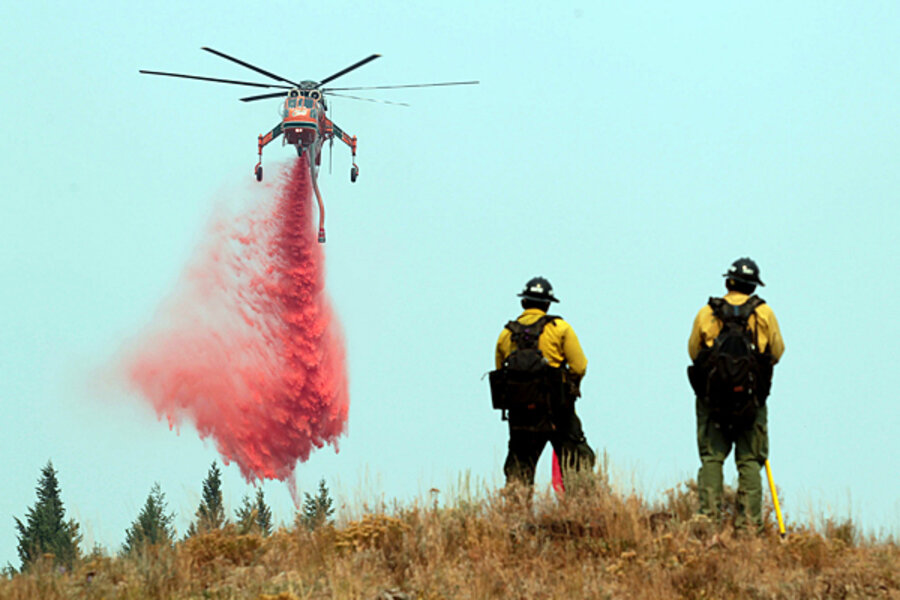Firefighters battle to turn tide against 'angry' wildfire near Idaho resort
Loading...
Firefighters are waging a furious battle against the Idaho wildfire that is threatening thousands of homes near the Sun Valley resort.
The Beaver Creek Fire has already consumed more than 100,000 acres and caused the evacuation of 2,300 homes near the communities of Ketchum and Hailey.
High winds, high temperatures, and rugged terrain have hampered firefighters efforts, though somewhat cooler conditions and cloud cover on Sunday helped firefighters limit its growth and create firebreaks.
Some 1,200 people and 19 aircraft are fighting the blaze, which started Aug. 7 with a lightning strike. According to InciWeb, it is now just 8 percent contained.
"Every fire has a personality, and this fire has an angry personality," Beth Lund, an incident commander with the US Forest Service team managing the fire, told Reuters.
Firefighters were using 14 helicopters on Monday to drop water on the blaze, up to 2,000 gallons at a time, and airplane tankers have dropped flame-retardant chemicals on key areas, including on Bald Mountain – the main hill at the Sun Valley ski resort.
Dry conditions in the sagebrush and pine forests have fed the blaze, and high winds have helped cause the fire's erratic and unpredictable behavior. But temperatures Monday were expected to be slightly cooler, with slightly higher humidity, and on Sunday, Ms. Lund expressed cautious optimism to Reuters. "I think we're getting to the point where we can start making some progress rather than just be on the defensive," she said.
The fire has drawn particular attention because of the high-end homes and destination setting of the tony resort area, where celebrities like Tom Hanks, Bruce Willis, and Arnold Schwarzenegger all have homes. Authorities have put the value of the threatened land and property in the area at around $8 billion.
On Friday, actor Richard Dreyvuss tweeted that "the #beavercreekfire is ravaging my family's hometown, Ketchum, ID. Thank you, firefighters, and be safe. Houses aren't worth lives" – a tweet that drew thanks from several firefighters.
And while the Beaver Creek fire has proved particularly difficult to get under control, it's one of just several blazes currently ravaging the state. According to the National Interagency Fire Center, based in Boise, there are nine large wildfires in Idaho which together have burned about 411,000 acres. Two other particularly large ones include the Pony Complex fire, which has scorched nearly 150,000 acres near Mountain Home, and the Elk Complex fire in the Boise National Forest, which has burned about 130,000 acres. Both those fires are mostly contained.
The center lists 47 large fires currently burning across 9 states in what has been a hot, dry summer – though the total acreage burned so far, about 3.3 million acres, is significantly less than the amount that had burned at this point in the last two years (over 6.5 million acres in both 2011 and 2012).
It's been a particularly destructive summer for the loss of life and property due to wildfires, however. Colorado experienced its most destructive wildfire ever in June, when two people were killed and about 500 homes destroyed in the Black Forest Fire near Colorado Springs. And later that month, 19 members of the Granite Mounains Hotshots were killed fighting the Yarnell Hill Fire in Arizona, one of the worst losses of firefighter lives ever.
On the Beaver Creek fire, firefighters Monday were hoping to perform some direct attacks on portions of the fire south of Ketchum, and to work in rugged terrain on the northernmost section of the blaze.
In Ketchum, normally a posh and busy resort town this time of year, news reports described a ghost town, with most businesses closed and residents evacuated.
“I’ve never seen it like this,” Dale Byington, general manager of The Sawtooth Club in Ketchum, told the Associated Press. The club was one of the few places open Sunday, but later shut down. “The only reason I opened was to give people here a place to go and get some food and drink, but that’s not going to happen.”
Material from Reuters and the Associated Press was used in this report.








